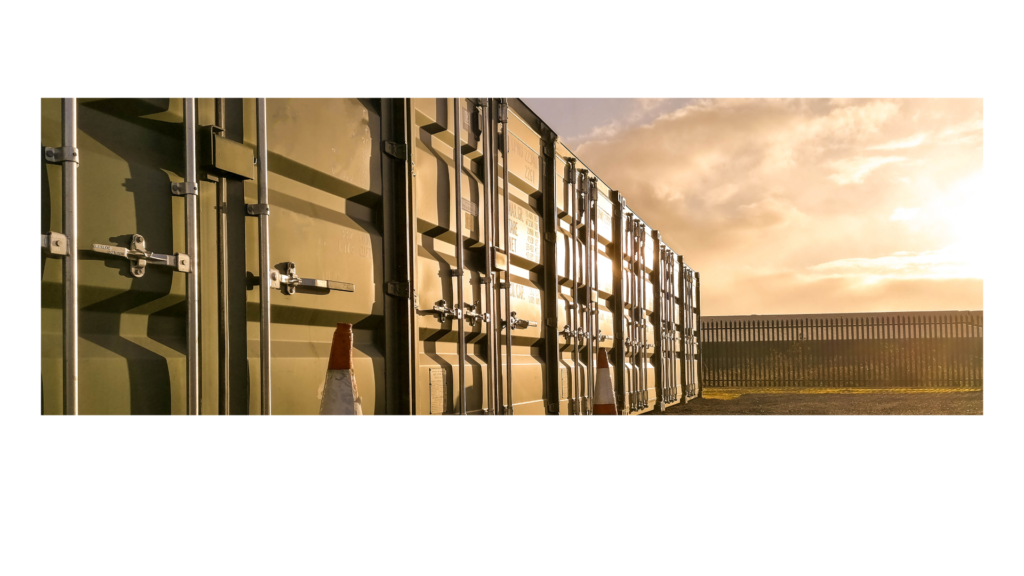
How Much Does a 10’ Shipping Container Cost? Buying and Rental Guide
Are you wondering how much a 10′ shipping container might cost? Here’s a breakdown of the cost to buy or rent 10-foot shipping containers in your area.
10-Foot Shipping Containers Buyers Guide
Purchasing a 10′ shipping container can be a smart investment for various purposes, whether for storage, modification, or as part of a construction project. Here’s a guide to help you understand the cost determinants and factors to consider.

New vs. Used Containers
- New: A brand-new 10′ container generally provides the guarantee of being in perfect condition. The cost for a new 10′ container can range from $2,500 to $4,500.
- Used: If you’re looking to save some money, used containers can be a great option. Depending on the condition (i.e., wear, tear, rust, dents), a used 10’ container could range between $1,600 and $2,900.
Shipping Container Type and Specifications
- Standard Dry Storage: This is the most common type. Prices generally fall in the range mentioned above.
- Refrigerated or Insulated: Containers designed to regulate temperature are more costly, often starting from $3,500 upwards for a 10′ size.
- Custom Containers: Modifications such as added windows, ventilation, or doors can increase the price.
Delivery Costs
Transporting your shipping container to your location can significantly impact your total cost. Depending on your location and the distance from the container depot, delivery fees can range from $100 to over $1,000.
Regional Variations
Prices can vary depending on where you’re purchasing. For instance, if you’re closer to a port or a major city where containers frequently arrive, it might be cheaper than in a more remote area.
Steel Shipping Container Supplier
Different suppliers have different pricing strategies, overheads, and volumes of sales. Always compare prices from various vendors before making a decision.
Additional Costs
- Inspection: Before purchasing a used container, you might want to hire an expert to inspect it. This can ensure it’s in good condition and watertight.
- Modifications: If you plan to convert the container into a living space or office, remember to factor in modification costs, which can significantly increase your total investment.
- Maintenance: Over time, containers may require maintenance like rust treatment or repainting.
Negotiate and Explore Discounts
Many vendors are open to negotiation, especially if you’re buying in bulk. Always ask for possible discounts.
Check for Deals Online
Platforms like Craigslist, eBay, or specialized container sale websites sometimes have deals or listings from private sellers who might be offloading containers at a lower rate.
A 10′ shipping container’s cost is influenced by various factors, from its condition to where you’re buying it. By understanding these factors, you can make an informed decision and get the best value for your money. Always remember to inspect, research, and compare before making your purchase.
New 10′ Shipping Container Cost
A new shipping container’s cost varies based on several factors.A standard new 10′ container typically ranged from $2,500 to $4,500. Here’s a breakdown of the primary drivers of these costs:

- Size & Type: Containers come in various sizes (10’, 20’, 40’, etc.) and types (dry storage, refrigerated, open-top, etc.). Bigger and specialized containers, like refrigerated ones, generally cost more.
- Manufacturing Costs: The raw materials (mainly steel), labor, and technology used in production influence the container’s price. Fluctuations in steel prices, for example, can affect container costs.
- Demand & Supply: The global shipping industry’s dynamics can impact container prices. A surge in demand or a shortage in supply can push prices up.
- Regional Variations: Proximity to ports or manufacturing hubs can reduce transportation and handling costs, making containers cheaper in such regions.
- Currency Exchange Rates: Since many containers are manufactured in countries like China, exchange rates can influence the final price in countries importing these containers.
While the price of a new shipping container is rooted in its size and type, external economic and industry-specific factors can significantly influence the final cost.
Refrigerated vs Insulated
Both refrigerated and insulated shipping containers are designed to transport temperature-sensitive goods, but they serve different functions and consequently, have different pricing structures. Here’s an explanation of their costs, especially for a 10-foot variant:
- 10-Foot Refrigerated Shipping Containers:
- Function: These are equipped with an integrated refrigeration unit to maintain a specific temperature range. They can cool or even freeze products, making them essential for transporting perishable items like meat, dairy, or certain pharmaceuticals.
- Cost Factors:
- Refrigeration Unit: The inclusion of a refrigeration mechanism increases the cost.
- Power Source: These containers require an external power source, contributing to the cost.
- Maintenance: The complex refrigeration system necessitates regular maintenance.
- Price Range: A new 10-foot refrigerated container can start from $5,600 – $8,900 and go upwards, depending on the specifications and brand of the refrigeration unit.
- 10-Foot Insulated Shipping Containers:
- Function: These containers are designed to maintain a steady internal temperature by resisting external temperature changes. They don’t actively cool or heat their contents but rather preserve the internal conditions for longer.
- Cost Factors:
- Insulation Material: The quality and type of insulation influence the price.
- Construction: These containers often have a unique build, like stainless steel interiors, to support insulation.
- Price Range: Generally cheaper than refrigerated containers, a new 10-foot insulated container might range between $5,000 to $7,000, depending on the quality of insulation and construction.
10-foot refrigerated containers are typically more expensive than insulated ones due to their active refrigeration systems. However, the exact cost can vary based on the quality, brand, and regional factors. Always get updated quotations from suppliers for the most accurate pricing.
Cost to Buy a Used 10′ Shipping Container
The cost of a used shipping container varies widely based on several influencing factors. A standard used 10′ container could be priced between $1,200 and $2,500. Here are the main determinants of these costs:
- Condition: The state of the container is paramount. A ‘cargo-worthy’ container that’s still fit for ocean transport might cost more than one deemed suitable only for storage. Factors like rust, dents, door functionality, and the integrity of the floor can affect its price.
- Age: Older containers might be cheaper, but they might also have more wear and tear, which could lead to higher maintenance costs in the long run.
- Supply & Demand: Economic dynamics, such as a surge in popularity of container homes or businesses needing temporary storage, can influence demand and subsequently, prices.
- Location: If you’re close to a major port or shipping hub, you might find more competitive prices due to higher supply. Conversely, remote locations might incur higher transportation fees, adding to the overall cost.
- Modifications: Used containers retrofitted with windows, ventilation, or shelving might command a higher price.
While the base cost of a used shipping container is influenced by its condition and age, other market and logistical factors can play significant roles in determining the final price.
Cost to Rent a 10′ Shipping Container
Renting a 10′ shipping container can be a cost-effective solution for temporary storage or transportation needs. The monthly rental cost for such a container typically ranged between $150 and $300. Several factors influence this price range:

The duration of the rental plays a crucial role. Generally, longer-term rentals might offer reduced monthly rates compared to short-term arrangements. The container’s condition also impacts the cost. Newer, well-maintained containers or those with added features like shelving or security enhancements can command higher rental fees.
Location is another significant factor. Proximity to urban centers or ports can affect availability and pricing. Delivering the container to a remote location could raise the overall cost due to transportation charges. Meanwhile, the purpose of the rental, such as whether it’s for storage or actual shipping, can also influence the price.
Supply and demand dynamics in the region play a role as well. For instance, during times of heightened construction activity or natural disasters, the demand for temporary storage solutions might spike, leading to increased rental costs. Lastly, the rental agency’s policies, overheads, and package deals can all influence the final price offered to customers.
10-foot Container Dimensions
The 10-foot shipping container is smaller than the standard 20-foot container and is used for smaller shipments or storage needs. Here are the general dimensions for a standard 10-foot container:

External Dimensions:
- Length: 10 feet (3.05 meters)
- Width: 8 feet (2.44 meters)
- Height: 8 feet 6 inches (2.59 meters)
Internal Dimensions:
- Length: 9 feet 3 inches (2.82 meters)
- Width: 7 feet 8 inches (2.34 meters)
- Height: 7 feet 10 inches (2.39 meters)
Door Opening:
- Width: 7 feet 8 inches (2.34 meters)
- Height: 7 feet 6 inches (2.28 meters)
Tare Weight:
- Approximately 2,645 lbs (1,200 kg)
Volume:
- Approximately 560 cubic feet (15.89 cubic meters)
Do note that while these dimensions are fairly standard, there might be slight variations based on the manufacturer or specific customization. If you need a container for a particular purpose, always double-check the exact dimensions from the supplier or manufacturer.
The Cost to Have a 10′ Container Shipped
Shipping a shipping container can be a complex process with a variety of costs involved. The cost will largely depend on the specifics of the shipment:
- Distance and Route: Naturally, the further you’re shipping the container, the more expensive it’ll be. Also, popular routes (like major transatlantic or transpacific lanes) might be more competitive in pricing than less-traveled routes.
- Size and Type of the Container: A 10-foot container will typically cost less to ship than a 20-foot one. Specialized containers, like refrigerated units, can also be more expensive due to their power and maintenance needs.
- Weight of the Cargo: Most freight forwarders charge based on the weight of the cargo, especially if it’s near or exceeds the container’s max payload.
- Mode of Transportation: Sea freight is the most common for containers and often the cheapest for long distances. However, road (trucking) or rail can be used for land-based transportation, and air freight (though rare for full containers) is the most expensive option.
- Origin and Destination Fees: Ports or transport hubs often have various fees, including loading/unloading, documentation, inspection, and customs duties (if crossing international borders).
- Seasonality: During peak seasons, like before major holidays or during harvest seasons for certain goods, shipping costs might increase due to higher demand.
- Fuel Prices: Fluctuations in oil and fuel prices can significantly impact shipping costs, especially for sea freight.
- Insurance: Depending on the value of the cargo, insurance can add to the overall cost.
- Brokerage or Forwarder Fees: If you’re using a freight broker or forwarder to handle the logistics, their service fees will be included in the total cost.
- Potential Delays or Issues: Unpredictable factors, like weather disruptions, strikes, or geopolitical events, can add costs due to delays or rerouting.
Shipping a full 40-foot container from China to the US could range from $4,000 to over $10,000 depending on the specifics mentioned. Prices are constantly changing, so it’s essential to get quotes from shipping lines or freight forwarders for the most accurate and up-to-date pricing.
